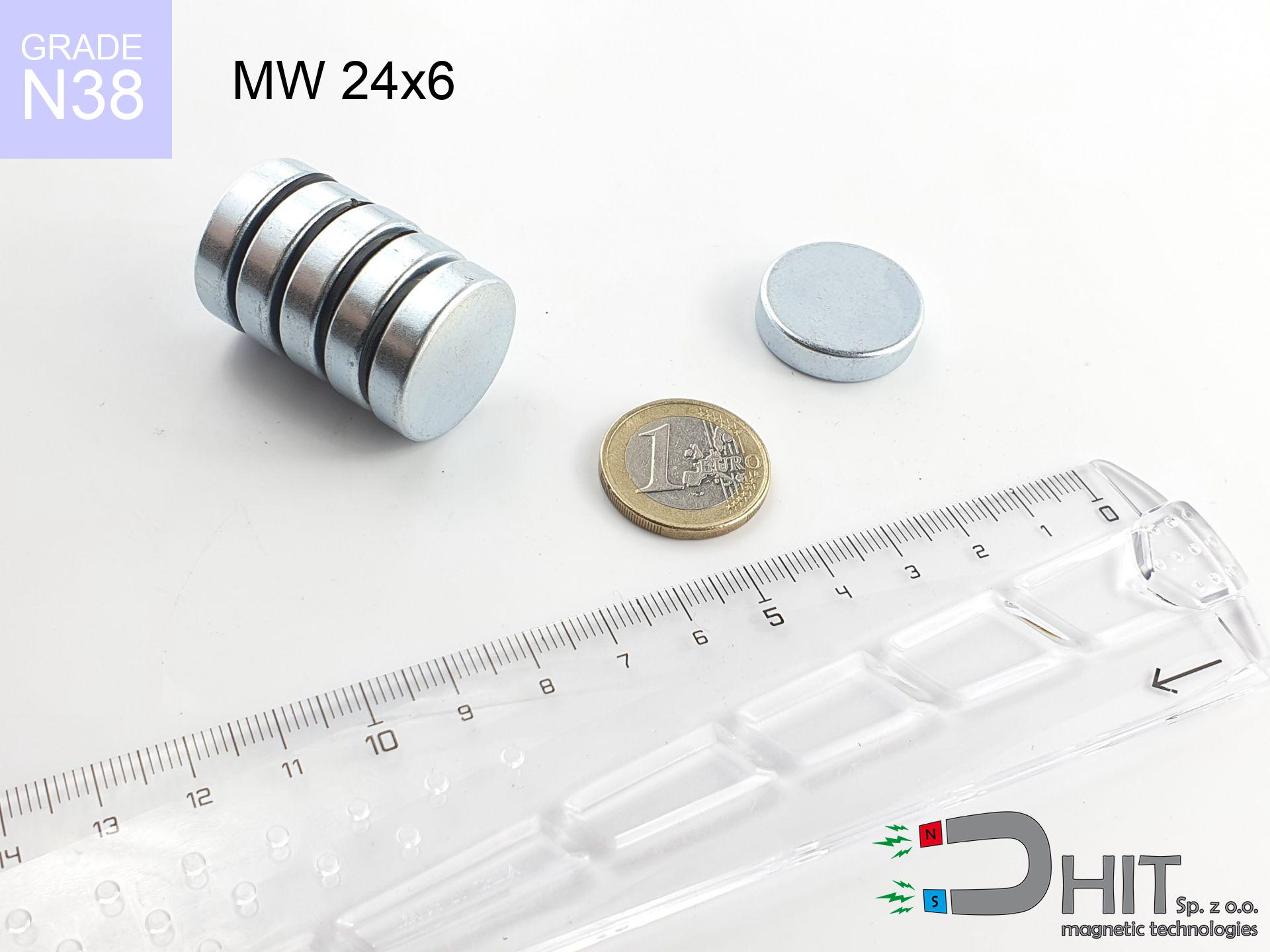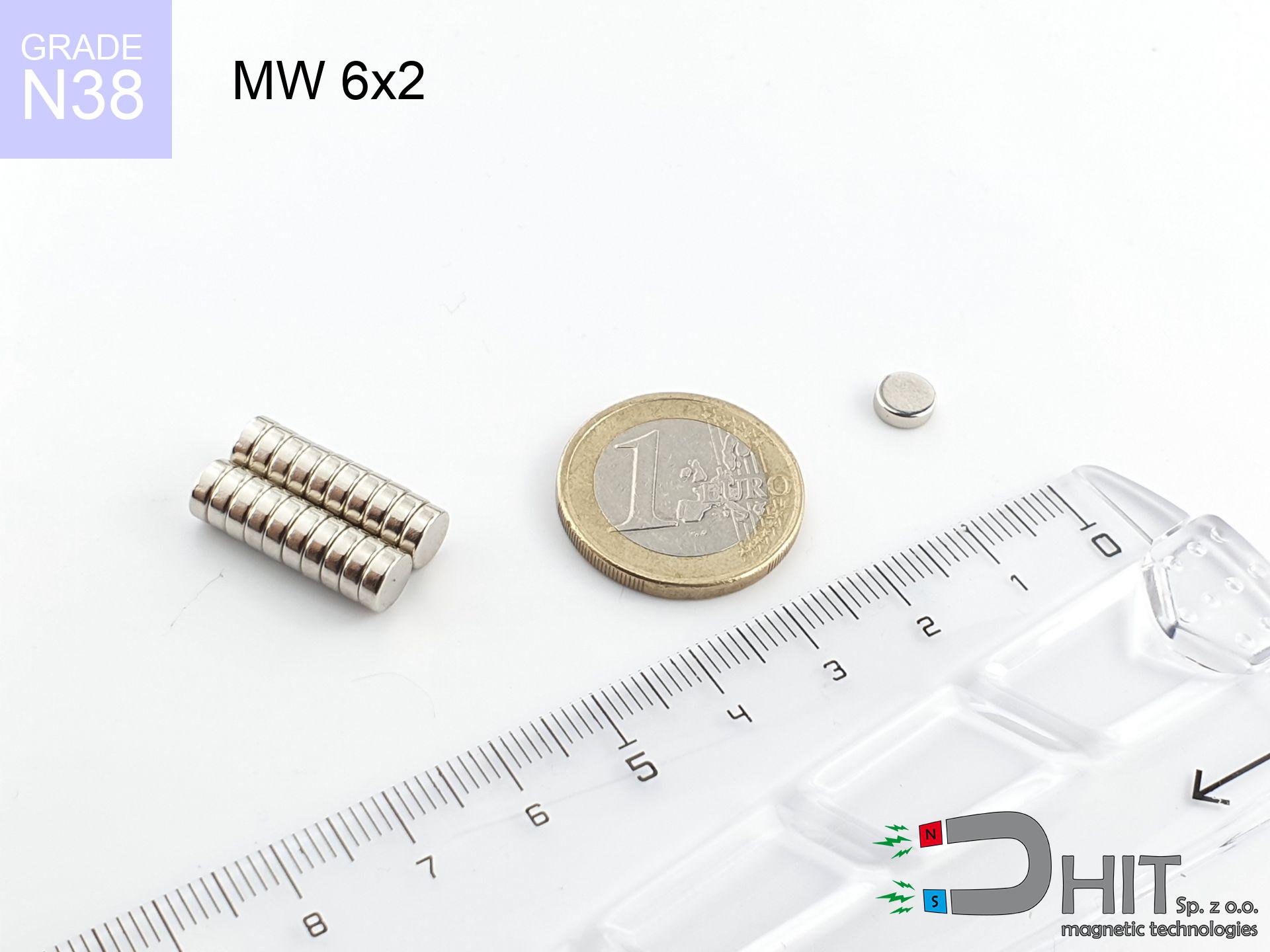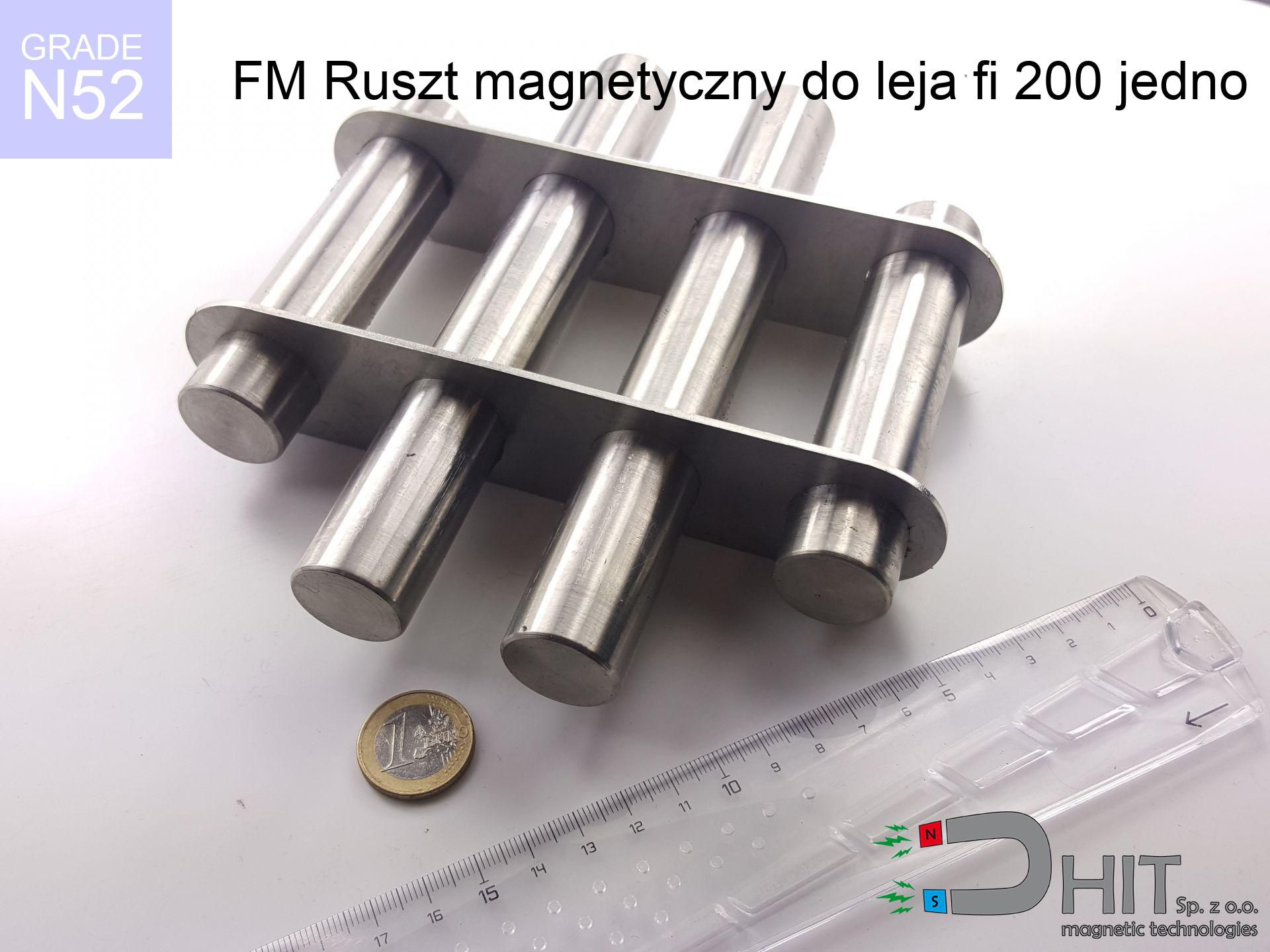MW 24x6 / N38 - cylindrical magnet
cylindrical magnet
Catalog no 010048
GTIN: 5906301810476
Diameter Ø
24 mm [±0,1 mm]
Height
6 mm [±0,1 mm]
Weight
20.36 g
Magnetization Direction
↑ axial
Load capacity
9.53 kg / 93.45 N
Magnetic Induction
277.18 mT
Coating
[Zn] Zinc
5.10 ZŁ with VAT / pcs + price for transport
4.15 ZŁ net + 23% VAT / pcs
bulk discounts:
Need more?Not sure what to buy?
Call us now
+48 22 499 98 98
if you prefer let us know using
contact form
our website.
Parameters along with shape of a neodymium magnet can be verified using our
online calculation tool.
Order by 14:00 and we’ll ship today!
MW 24x6 / N38 - cylindrical magnet
Specification / characteristics MW 24x6 / N38 - cylindrical magnet
| properties | values |
|---|---|
| Cat. no. | 010048 |
| GTIN | 5906301810476 |
| Production/Distribution | Dhit sp. z o.o. |
| Country of origin | Poland / China / Germany |
| Customs code | 85059029 |
| Diameter Ø | 24 mm [±0,1 mm] |
| Height | 6 mm [±0,1 mm] |
| Weight | 20.36 g |
| Magnetization Direction | ↑ axial |
| Load capacity ~ ? | 9.53 kg / 93.45 N |
| Magnetic Induction ~ ? | 277.18 mT |
| Coating | [Zn] Zinc |
| Manufacturing Tolerance | ±0.1 mm |
Magnetic properties of material N38
| properties | values | units |
|---|---|---|
| remenance Br [Min. - Max.] ? | 12.2-12.6 | kGs |
| remenance Br [Min. - Max.] ? | 1220-1260 | T |
| coercivity bHc ? | 10.8-11.5 | kOe |
| coercivity bHc ? | 860-915 | kA/m |
| actual internal force iHc | ≥ 12 | kOe |
| actual internal force iHc | ≥ 955 | kA/m |
| energy density [Min. - Max.] ? | 36-38 | BH max MGOe |
| energy density [Min. - Max.] ? | 287-303 | BH max KJ/m |
| max. temperature ? | ≤ 80 | °C |
Physical properties of sintered neodymium magnets Nd2Fe14B at 20°C
| properties | values | units |
|---|---|---|
| Vickers hardness | ≥550 | Hv |
| Density | ≥7.4 | g/cm3 |
| Curie Temperature TC | 312 - 380 | °C |
| Curie Temperature TF | 593 - 716 | °F |
| Specific resistance | 150 | μΩ⋅Cm |
| Bending strength | 250 | Mpa |
| Compressive strength | 1000~1100 | Mpa |
| Thermal expansion parallel (∥) to orientation (M) | (3-4) x 106 | °C-1 |
| Thermal expansion perpendicular (⊥) to orientation (M) | -(1-3) x 10-6 | °C-1 |
| Young's modulus | 1.7 x 104 | kg/mm² |
Engineering modeling of the assembly - report
The following information represent the result of a physical analysis. Values rely on models for the material NdFeB. Operational performance may differ. Please consider these calculations as a preliminary roadmap when designing systems.
MW 24x6 / N38
| Distance (mm) | Induction (Gauss) / mT | Pull Force (kg) | Risk Status |
|---|---|---|---|
| 0 mm |
2771 Gs
277.1 mT
|
9.53 kg / 9530.0 g
93.5 N
|
warning |
| 1 mm |
2609 Gs
260.9 mT
|
8.45 kg / 8447.5 g
82.9 N
|
warning |
| 2 mm |
2420 Gs
242.0 mT
|
7.27 kg / 7266.5 g
71.3 N
|
warning |
| 5 mm |
1805 Gs
180.5 mT
|
4.04 kg / 4042.4 g
39.7 N
|
warning |
| 10 mm |
991 Gs
99.1 mT
|
1.22 kg / 1218.3 g
12.0 N
|
low risk |
| 15 mm |
542 Gs
54.2 mT
|
0.36 kg / 364.2 g
3.6 N
|
low risk |
| 20 mm |
313 Gs
31.3 mT
|
0.12 kg / 121.5 g
1.2 N
|
low risk |
| 30 mm |
125 Gs
12.5 mT
|
0.02 kg / 19.5 g
0.2 N
|
low risk |
| 50 mm |
34 Gs
3.4 mT
|
0.00 kg / 1.4 g
0.0 N
|
low risk |
MW 24x6 / N38
| Surface type | Friction coefficient / % Mocy | Max load (kg) |
|---|---|---|
| Raw steel |
µ = 0.3
30% Nominalnej Siły
|
2.86 kg / 2859.0 g
28.0 N
|
| Painted steel (standard) |
µ = 0.2
20% Nominalnej Siły
|
1.91 kg / 1906.0 g
18.7 N
|
| Oily/slippery steel |
µ = 0.1
10% Nominalnej Siły
|
0.95 kg / 953.0 g
9.3 N
|
| Magnet with anti-slip rubber |
µ = 0.5
50% Nominalnej Siły
|
4.77 kg / 4765.0 g
46.7 N
|
MW 24x6 / N38
| Steel thickness (mm) | % power | Real pull force (kg) |
|---|---|---|
| 0.5 mm |
|
0.95 kg / 953.0 g
9.3 N
|
| 1 mm |
|
2.38 kg / 2382.5 g
23.4 N
|
| 2 mm |
|
4.77 kg / 4765.0 g
46.7 N
|
| 5 mm |
|
9.53 kg / 9530.0 g
93.5 N
|
| 10 mm |
|
9.53 kg / 9530.0 g
93.5 N
|
MW 24x6 / N38
| Ambient temp. (°C) | Power loss | Remaining pull | Status |
|---|---|---|---|
| 20 °C | 0.0% |
9.53 kg / 9530.0 g
93.5 N
|
OK |
| 40 °C | -2.2% |
9.32 kg / 9320.3 g
91.4 N
|
OK |
| 60 °C | -4.4% |
9.11 kg / 9110.7 g
89.4 N
|
OK |
| 80 °C | -6.6% |
8.90 kg / 8901.0 g
87.3 N
|
|
| 100 °C | -28.8% |
6.79 kg / 6785.4 g
66.6 N
|
MW 24x6 / N38
| Gap (mm) | Attraction (kg) (N-S) | Repulsion (kg) (N-N) |
|---|---|---|
| 0 mm |
14.29 kg / 14295.0 g
140.2 N
|
N/A |
| 2 mm |
10.91 kg / 10905.0 g
107.0 N
|
10.18 kg / 10178.0 g
99.8 N
|
| 5 mm |
6.06 kg / 6060.0 g
59.4 N
|
5.66 kg / 5656.0 g
55.5 N
|
| 10 mm |
1.83 kg / 1830.0 g
18.0 N
|
1.71 kg / 1708.0 g
16.8 N
|
| 20 mm |
0.18 kg / 180.0 g
1.8 N
|
0.17 kg / 168.0 g
1.6 N
|
| 50 mm |
0.00 kg / 0.0 g
0.0 N
|
0.00 kg / 0.0 g
0.0 N
|
MW 24x6 / N38
| Object / Device | Limit (Gauss) / mT | Safe distance |
|---|---|---|
| Pacemaker | 5 Gs (0.5 mT) | 10.0 cm |
| Hearing aid | 10 Gs (1.0 mT) | 8.0 cm |
| Mechanical watch | 20 Gs (2.0 mT) | 6.5 cm |
| Phone / Smartphone | 40 Gs (4.0 mT) | 5.0 cm |
| Remote | 50 Gs (5.0 mT) | 4.5 cm |
| Payment card | 400 Gs (40.0 mT) | 2.0 cm |
| HDD hard drive | 600 Gs (60.0 mT) | 1.5 cm |
MW 24x6 / N38
| Start from (mm) | Speed (km/h) | Energy (J) | Predicted outcome |
|---|---|---|---|
| 10 mm |
23.50 km/h
(6.53 m/s)
|
0.43 J | |
| 30 mm |
37.84 km/h
(10.51 m/s)
|
1.12 J | |
| 50 mm |
48.79 km/h
(13.55 m/s)
|
1.87 J | |
| 100 mm |
69.00 km/h
(19.17 m/s)
|
3.74 J |
MW 24x6 / N38
| Technical parameter | Value / Description |
|---|---|
| Coating type | [Zn] Zinc |
| Layer structure | Zn (Zinc) |
| Layer thickness | 8-15 µm |
| Salt spray test (SST) ? | 48 h |
| Recommended environment | Indoors / Garage |
MW 24x6 / N38
| Environment | Effective steel pull | Effect |
|---|---|---|
| Air (land) | 9.53 kg | Standard |
| Water (riverbed) |
10.91 kg
(+1.38 kg Buoyancy gain)
|
+14.5% |
Other deals
Strengths as well as weaknesses of NdFeB magnets.
Besides their stability, neodymium magnets are valued for these benefits:
- They have constant strength, and over around ten years their attraction force decreases symbolically – ~1% (according to theory),
- They feature excellent resistance to weakening of magnetic properties when exposed to external magnetic sources,
- A magnet with a metallic gold surface is more attractive,
- Magnetic induction on the working part of the magnet remains strong,
- Made from properly selected components, these magnets show impressive resistance to high heat, enabling them to function (depending on their form) at temperatures up to 230°C and above...
- In view of the ability of flexible molding and customization to specialized needs, neodymium magnets can be created in a variety of shapes and sizes, which makes them more universal,
- Fundamental importance in high-tech industry – they are used in data components, electric motors, diagnostic systems, and other advanced devices.
- Compactness – despite small sizes they offer powerful magnetic field, making them ideal for precision applications
Drawbacks and weaknesses of neodymium magnets and proposals for their use:
- Brittleness is one of their disadvantages. Upon strong impact they can break. We advise keeping them in a special holder, which not only protects them against impacts but also increases their durability
- Neodymium magnets demagnetize when exposed to high temperatures. After reaching 80°C, many of them experience permanent weakening of strength (a factor is the shape as well as dimensions of the magnet). We offer magnets specially adapted to work at temperatures up to 230°C marked [AH], which are extremely resistant to heat
- Due to the susceptibility of magnets to corrosion in a humid environment, we advise using waterproof magnets made of rubber, plastic or other material resistant to moisture, in case of application outdoors
- Due to limitations in creating nuts and complicated forms in magnets, we recommend using cover - magnetic mechanism.
- Possible danger resulting from small fragments of magnets pose a threat, if swallowed, which is particularly important in the aspect of protecting the youngest. Furthermore, tiny parts of these devices can be problematic in diagnostics medical after entering the body.
- With budget limitations the cost of neodymium magnets is a challenge,
Detachment force of the magnet in optimal conditions – what it depends on?
Holding force of 9.53 kg is a result of laboratory testing performed under specific, ideal conditions:
- using a sheet made of mild steel, functioning as a ideal flux conductor
- with a cross-section of at least 10 mm
- characterized by smoothness
- without any air gap between the magnet and steel
- under vertical force vector (90-degree angle)
- at temperature room level
Determinants of practical lifting force of a magnet
Bear in mind that the application force will differ subject to elements below, in order of importance:
- Clearance – the presence of foreign body (paint, dirt, gap) interrupts the magnetic circuit, which reduces capacity rapidly (even by 50% at 0.5 mm).
- Force direction – note that the magnet has greatest strength perpendicularly. Under shear forces, the holding force drops drastically, often to levels of 20-30% of the maximum value.
- Metal thickness – the thinner the sheet, the weaker the hold. Part of the magnetic field penetrates through instead of converting into lifting capacity.
- Steel grade – the best choice is pure iron steel. Hardened steels may have worse magnetic properties.
- Surface finish – ideal contact is obtained only on smooth steel. Any scratches and bumps reduce the real contact area, reducing force.
- Thermal factor – high temperature weakens magnetic field. Too high temperature can permanently demagnetize the magnet.
* Holding force was checked on the plate surface of 20 mm thickness, when the force acted perpendicularly, however under parallel forces the holding force is lower. Moreover, even a slight gap {between} the magnet and the plate reduces the load capacity.
H&S for magnets
Compass and GPS
GPS units and smartphones are extremely susceptible to magnetic fields. Close proximity with a powerful NdFeB magnet can permanently damage the internal compass in your phone.
Mechanical processing
Fire hazard: Neodymium dust is highly flammable. Do not process magnets in home conditions as this risks ignition.
Pinching danger
Protect your hands. Two large magnets will join immediately with a force of massive weight, destroying anything in their path. Exercise extreme caution!
Warning for allergy sufferers
Certain individuals suffer from a contact allergy to Ni, which is the typical protective layer for NdFeB magnets. Prolonged contact can result in a rash. It is best to use protective gloves.
ICD Warning
For implant holders: Powerful magnets disrupt medical devices. Maintain at least 30 cm distance or request help to work with the magnets.
Choking Hazard
Only for adults. Tiny parts pose a choking risk, leading to serious injuries. Store out of reach of kids and pets.
Maximum temperature
Monitor thermal conditions. Exposing the magnet above 80 degrees Celsius will destroy its properties and pulling force.
Conscious usage
Before use, read the rules. Sudden snapping can break the magnet or hurt your hand. Be predictive.
Risk of cracking
NdFeB magnets are ceramic materials, meaning they are fragile like glass. Impact of two magnets will cause them breaking into shards.
Electronic hazard
Data protection: Neodymium magnets can ruin payment cards and sensitive devices (pacemakers, medical aids, mechanical watches).
Warning!
More info about risks in the article: Magnet Safety Guide.







![UI 45x13x5 [M301] / N38 - badge holder UI 45x13x5 [M301] / N38 - badge holder](https://cdn3.dhit.pl/graphics/products/ui45x13x5-m301-vud.jpg)

